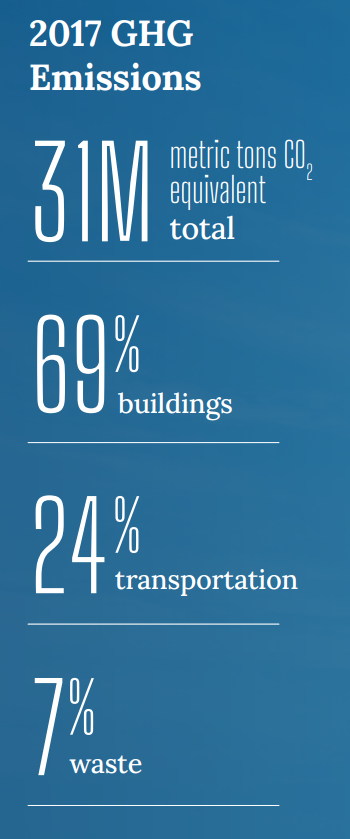Electrify Chicago
An independent tool for viewing City of Chicago building data
According to the
2022 Chicago Climate Action Plan,
69% of Chicago's emissions come from buildings, making
building emissions our biggest challenge and our biggest opportunity as a city
to tackle climate change. At Electrify Chicago, we showcase building performance using
publicly available data supplemented by community-submitted photographs and building
owners.
Start by looking at Chicago's buildings with the highest greenhouse gas intensity i.e. emissions per square foot. Large, efficient, buildings can perform much better than very inefficient small buildings on this metric.
New Article
📰 $30 Million In Missed Fines
The City Of Chicago failed to collect $30 million in potential fines from the building benchmarking ordinance, reducing transparency and accountability.
Legislative update! 🎉
As of late January 2024, legislation is being introduced to require new use more efficient forms of water and space heating, via the Clean And Affordable Buildings Ordinance (CABO), which will reduce the number of highly polluting and inefficient buildings that end up on this site.
If you're in Chicago,
write to your alderman to support the CABO!
Chicago Buildings by Greenhouse Gas Intensity
Note: Data includes large Chicago buildings with data from 2022, unless explicitly stated otherwise.
Note: This data only includes buildings whose emissions are reported
under the
Chicago Energy Benchmarking Ordinance. According to the City “As of 2016,
this list includes all commercial, institutional, and residential buildings larger than
50,000 square feet.” This dataset is also then filtered to only buildings with
reported emissions > 1,000 metric tons CO2 equivalent.
The latest year of data is from 2022, but we update the site regularly when new data is available, and some buildings may have failed to report that year, and only have older data available.
| Property Name / address | Primary Property Type |
Greenhouse Gas Intensity (kg CO2 eq./sqft) |
Total Greenhouse Emissions (metric tons CO2 eq.) |
|---|---|---|---|
|
McCormick Tribune Campus Center (MTCC)
📷
🕰️
(Illinois Tech)
3201 S State Street
| College/University | 12.3 kg/sqft | 1,151 tons |
|
City Hall
(Chicago)
121 N LaSalle St
| Office | 12.3 kg/sqft
Highest 8%
| 5,045 tons
Highest 7%
|
|
Malcolm X College
🕰️
1900 West Van Buren Street
| College/University | 12.3 kg/sqft | 6,671 tons |
|
Aviation Lofts
🕰️
1340 S MICHIGAN AVE
| Multifamily Housing | 12.3 kg/sqft | 614 tons |
|
Wentworth Rehab and Healthcare Center
201 W 69TH ST
| Senior Living Community | 12.3 kg/sqft
Highest 8%
| 1,104 tons
Highest 42%
|
|
Womans Athletic Club Chicago
🕰️
626 640 N Michigan
| Social/Meeting Hall | 12.3 kg/sqft | 1,049 tons |
|
Navy Pier, Inc.
🚩
📷
600 E Grand Ave
| Mixed Use Property | 12.3 kg/sqft
Highest 8%
| 14,089 tons #36 Highest
|
|
Advocate Illinois Masonic Medical Center
🚩
836 W Wellington Ave
| Hospital (General Medical & Surgical) | 12.3 kg/sqft
Highest 8%
| 15,611 tons #30 Highest
|
|
259 E Erie St
259 E Erie St
| Medical Office | 12.3 kg/sqft
Highest 8%
| 8,489 tons
Highest 3%
|
|
Northeastern Illinois University
🕰️
5500 N. Saint Louis Avenue
| College/University | 12.3 kg/sqft | 15,478 tons |
|
Siegel Hall
🕰️
(Illinois Tech)
3301 S State Street
| College/University | 12.2 kg/sqft | 775 tons |
|
Viceroy Chicago
🕰️
1118 N State Street
| Hotel | 12.2 kg/sqft | 1,638 tons |
|
Martin Luther King Community Center
(Chicago)
4314 S Cottage Grove Ave
| Other - Entertainment/Public Assembly | 12.2 kg/sqft
Highest 8%
| 690 tons
Lowest 39%
|
|
The Womens Treatment Center
🕰️
140 N Ashland Ave
| Residential Care Facility | 12.2 kg/sqft | 1,273 tons |
|
Courtyard Marriot
30 E Hubbard St
| Hotel | 12.2 kg/sqft
Highest 8%
| 2,477 tons
Highest 18%
|
Data Source:
Chicago Energy Benchmarking Data
